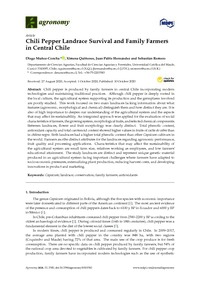Mostrar el registro sencillo de la publicación
Chili pepper landrace survival and family farmers in central Chile
| dc.contributor.author | Muñoz-Concha, Diego | |
| dc.contributor.author | Quiñones, Ximena | |
| dc.contributor.author | Hernandez, Juan Pablo | |
| dc.contributor.author | Romero, Sebastián | |
| dc.date.accessioned | 2021-10-27T19:13:24Z | |
| dc.date.available | 2021-10-27T19:13:24Z | |
| dc.date.issued | 2020 | |
| dc.identifier.uri | http://repositorio.ucm.cl/handle/ucm/3424 | |
| dc.description.abstract | Chili pepper is produced by family farmers in central Chile incorporating modern technologies and maintaining traditional practices. Although chili pepper is deeply rooted in the local culture, the agricultural system supporting its production and the germplasm involved are poorly studied. This work focused on two main landraces lacking information about what features (agronomic, morphological and chemical) distinguish them and how distinct they are. It is also of high importance to deepen our understanding of the agricultural system and the aspects that may affect its sustainability. An integrated approach was applied for the evaluation of social characteristics of farmers, the growing system, morphological traits, and selected chemical components. Between landraces, flower and fruit morphology was clearly distinct. Total phenolic content, antioxidant capacity and total carotenoid content showed higher values in fruits of cacho de cabra than in chileno negro. Both landraces had a higher total phenolic content than other Capsicum cultivars in the world. Farmers ascribe distinct attributes for the landraces regarding agronomic performance, fruit quality and processing applications. Characteristics that may affect the sustainability of the agricultural system are small farm size, relatives working as employees, and low farmers’ educational attainment. The study landraces are distinct and represent unique genetic material produced in an agricultural system facing important challenges where farmers have adapted to socio-economic pressures, externalizing plant production, reducing harvest costs, and developing innovations in product and marketing. | es_CL |
| dc.language.iso | en | es_CL |
| dc.rights | Atribución-NoComercial-SinDerivadas 3.0 Chile | * |
| dc.rights | Atribución-NoComercial-SinDerivadas 3.0 Chile | * |
| dc.rights.uri | http://creativecommons.org/licenses/by-nc-nd/3.0/cl/ | * |
| dc.source | Agronomy, 10(10), 1541 | es_CL |
| dc.subject | Capsicum annuum L. | es_CL |
| dc.subject | Landrace | es_CL |
| dc.subject | Conservation | es_CL |
| dc.subject | Family farmers | es_CL |
| dc.subject | Antioxidants compounds | es_CL |
| dc.title | Chili pepper landrace survival and family farmers in central Chile | es_CL |
| dc.type | Article | es_CL |
| dc.ucm.facultad | Facultad de Ciencias Agrarias y Forestales | es_CL |
| dc.ucm.indexacion | Scopus | es_CL |
| dc.ucm.indexacion | Otro | es_CL |
| dc.ucm.uri | www.mdpi.com/2073-4395/10/10/1541 | es_CL |
| dc.ucm.doi | doi.org/10.3390/agronomy10101541 | es_CL |



